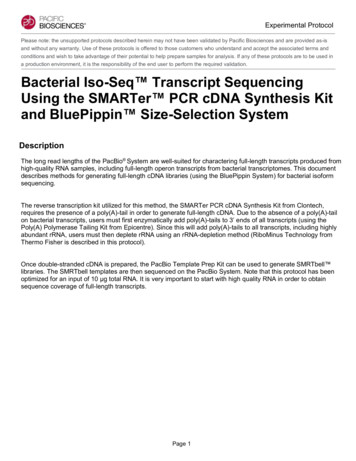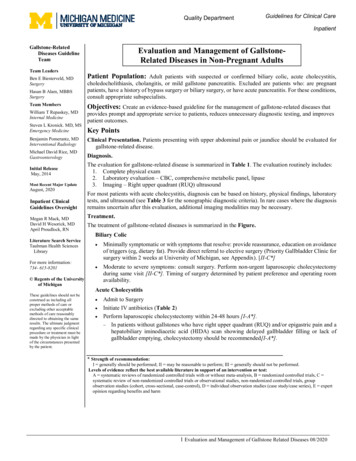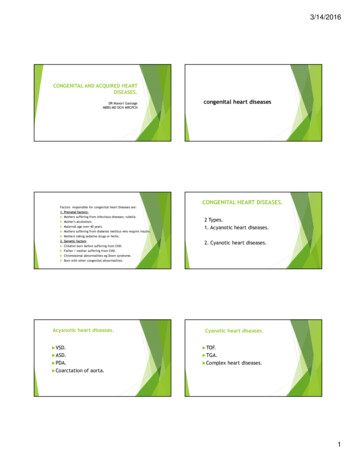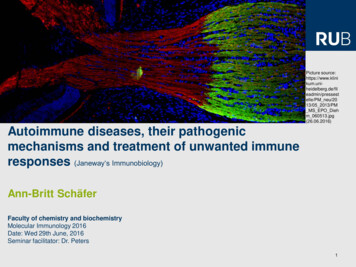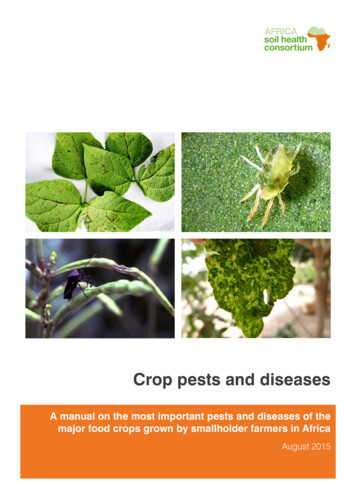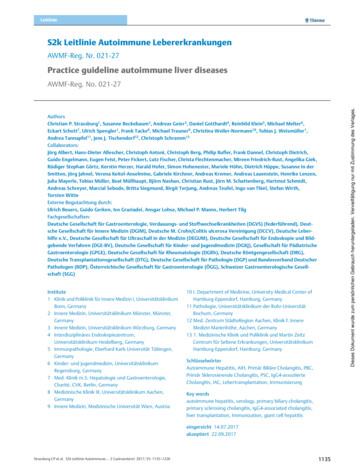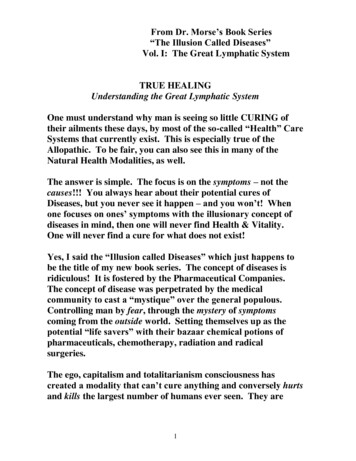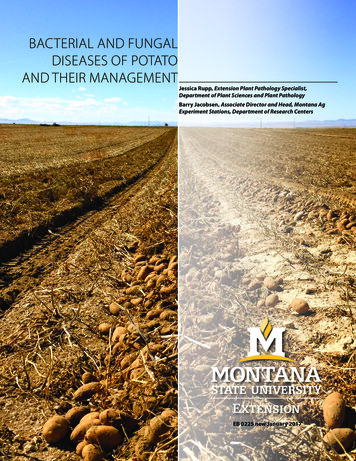
Transcription
BACTERIAL AND FUNGALDISEASES OF POTATOAND THEIR MANAGEMENTJessica Rupp, Extension Plant Pathology Specialist,Department of Plant Sciences and Plant PathologyBarry Jacobsen, Associate Director and Head, Montana AgExperiment Stations, Department of Research CentersEB 0225 new January 2017
THE SEED POTATO INDUSTRY IN MONTANASeed potatoes are an important crop in Montana andare a crucial quality seed source for potato productionacross the United States. The cooperation of commercialproducers and home gardeners to control diseases of greatconcern, such as late blight, is essential.Montana is one of the top five seed-potato producingstates. According to the Montana Department ofAgriculture, the state’s seed potatoes are prized becausegrowing areas are somewhat isolated from airborne sporesof diseases such as late blight. To protect this industry,Montana only allows potatoes that originate in Montana tobe grown as certified seed, and requires all seed potatoesto be inspected at their shipping point. Businesses cansell garden seed potatoes from outside Montana, butneed to be inspected at the point of shipping and have anaccompanying health certificate.BACTERIAL DISEASESBlacklegAeiral Stem RotSoft RotRing RotBrown RotDickeya BlacklegCommon Scab1122556FUNGAL DISEASESAlternaria Brown SpotEarly BlightLate BlightPowdery Mildew6789Glossary9 2017 The U.S. Department of Agriculture (USDA), Montana State University and Montana State University Extension prohibit discrimination inall of their programs and activities on the basis of race, color, national origin, gender, religion, age, disability, political beliefs, sexual orientation,and marital and family status. Issued in furtherance of cooperative extension work in agriculture and home economics, acts of May 8 and June30, 1914, in cooperation with the U.S. Department of Agriculture, Jeff Bader, Director, Montana State University Extension, Bozeman, MT 59717.Information in this document is provided for educational purposes only. Reference to commercial products or trade names does not imply an endorsement of them by MSU Extension.Common chemical and trade names are used in this publication for clarity for the reader. Inclusion of a common chemical or trade name does not imply endorsement of that particularproduct or brand of herbicide and exclusion does not imply non-approval. This publication is not intended to replace the product label.
1BACTERIAL DISEASES OF POTATO AND THEIR MANAGEMENT IN MONTANABLACKLEG, AERIAL STEM ROT and SOFT ROT are all caused by bacteria, that via their production of pectolyticenzymes cause a wet, mushy rot of tissues they infect. Pectolytic enzymes dissolve the middle lamella, composed ofpectin, which holds plant cells together.BLACKLEGAERIAL STEM ROTGeneral InformationGeneral InformationCurrently in Montana, blackleg is most commonly causedby Pectobacterium spp. In the United Kingdom and Europeanother genus of soft rot bacteria, Dickeya spp. can causeblackleg and this will be discussed separately.As infected tubers are the source of this disease andthe pathogen is easily spread during seed cutting, blacklegis of great concern to certified seed growers. This diseasehas been minimized by the tissue culture-based, flush-outcertification system used by Montana seed growers.Aerial stem rot, also known as aerial blackleg, aerial softrot, or bacterial stem rot can be found anywhere potatoesare grown. This disease can be caused by several differentbacteria including: Pectobacterium carotovorum subsp.carotovorum (syn. Erwinia carotovora subsp. carotovora),Pectobacterium atrosepticum and Dickeya dianthicola(syn. Erwinia chrysanthemi). In Montana, aerial stem rot istypically caused by Pectobacterium carotovorum subsp.carotovorum, the causal agent of soft rot.Symptoms and SpreadSymptoms and SpreadBlackleg symptoms include soft rot of seed pieces, black tobrown discoloration of the stem extending from the seedpiece to above ground portions of the stem, and stuntingand wilting of affected stems (Figure 1). In some cases onlythe interior of the stem may show discoloration. Blackleginfected tubers can show soft rot symptoms in storage, butsymptom development is favored by wet soils at plantingand temperatures between 50 and 60ºF before emergenceand 68 F after emergence. Under unfavorable conditionsfor disease development, plants may be asymptomatic.ManagementThe key to management of Blackleg is disease-free seed.Cleaning seed handling, planting, and cutting equipmentis important and this will be discussed in the Soft Rot/RingRot disease sections.Aerial stem rot often begins as a water-soaked lesionon the stem that becomes a soft, rotted area. Under dryconditions, stems appear shriveled and dark, while in wet,humid conditions appear soft and slightly water soaked.Internal stem pith is often discolored outside the boundaryof lesion edges. When present, external discolorationdue to decay ranges from dark green to dark brown, andblack. The infection is not tuber borne, and often remainsconfined to the aboveground portion of the plant. Steminfections occur through wounds or natural openings,such as a leaf scar. Affected stems become wilted andoften die. Aerial stem rot is differentiated from blackleg byoccurring higher up the stem and spreading downward,whereas blackleg occurs from the ground up. The soft rotbacterium is a common soil inhabitant and is spread byFIGURE 1. Typical blackleg infectionFIGURE 2. Aerial stem rot following hail eventPhoto: Payton Strawser, The Ohio State UniversityPhoto: Barry Jacobsen, Montana State University
2BACTERIAL & FUNGAL DISEASES OF POTATO AND THEIR MANAGEMENT IN MONTANAirrigation, splashing water or insects. This bacterium mustinfect through wounds with hail injury (Figure 2, page 1)and mechanical damage (equipment, blowing sand) beingthe most common routes for infection. Where Europeancorn borer is found, their oviposition and feeding sites areanother common infection site. Under moist conditionsdecay is soft and slimy. Factors that lead to prolongedcanopy wetness such as rain, dense canopies, excessivenitrogen fertilization, etc. are predisposing factors. Underdry conditions infected tissues rapidly shrivel, and dryup. Warm to hot temperatures are favorable for bacterialreplication. Simple molecular laboratory tests can easilydifferentiate black leg from soft rot bacteria.ManagementManagement of the disease can prove difficult. Thesuggestions for integrated control follow.1. Plant only clean, certified seed potatoes.2. Use whole tubers, or allow cut seed pieces tosuberize, or cork over, before planting.3. Use recommended plant spacing.4. Avoid over irrigation, use less frequent irrigation, withlonger durations. Early day irrigation allows for dryingto occur later in the day.5. Avoid over fertilization (especially nitrogen) to preventexcessive vine growth.6. Avoid stem damage during hilling and use optimalsanitation practicesThe use of copper-based fungicides with or withoutmancozeb is recommended after hail events. Sprayprograms with famadone cymoxanil mancozeb andcopper hydroxide mancozeb have been shown to reducedisease incidence and severity.favored by 70-80ºF temperatures, but can be active at anytemperature between 32 and 90ºF with decay and bacteriareproduction being sharply retarded below 50ºF. Soft rotbacteria spread from infected to non-infected tubers viawater films in storage.Symptoms and SpreadSymptoms of soft rot are characterized by soft, mushydecay of tuber tissue. Rotted tissues are typically creamto tan in color. When infected tubers are cut, the marginof the rotted area will turn brown to black with a clearboundary between the rotted and sound tissue. Initialdecay is relatively odorless, but as other bacteria begin togrow within the rotted tissue, the odor will become foul.When tubers are harvested from wet soils or washed beforestorage, lenticel infection is common. Lenticel infections aretypically ¼-½ inch in diameter and while still moist, maybe raised and slightly darker than the potato skin. Flesh upto ½ inch deep under the infected lenticel is water-soakedand yellow to cream in color. When these infections dryout under dry or cold conditions, they are typically slightlysunken. Un-suberized bruises or wounds are commonentry points and seed decay is common when seed pieceshave not been properly suberized before planting. Typicalsymptoms of soft rot are shown in Figures 3.ManagementManagement of soft rot requires addressing the everpresent pathogen and its requirement for wounds ordamaged tissues for infection. The following are importantsuggestions.1. Avoid harvest when temperatures are 65-75ºF,particularly when conditions are wet.2. Have good skin set before harvest. Generally thisrequires 10-14 days post vine kill.SOFT ROTGeneral InformationThis disease can be caused by any one of severalpectolytic bacteria including: Pectobacterium carotovorumsubsp. carotovorum, Pectobacterium carotovorum subsp.odoriferum, Pectobacterium atrosepticum, Dickeyadianthicola (syn. Erwinia chrysanthemi), and certainstrains of bacteria in the genus Pseudomonas, Bacillus andClostridium. Decay by Clostridium species usually onlyoccurs under anaerobic conditions. Soft rot decay of seedpieces and potatoes in storage is most commonly causedby Pectobacterium carotovorum subsp. carotovorum, acommon soil- and surface water-inhabiting bacteria. Asidefrom potato it can cause soft rot of nearly any non-woodyplant part. This ever-present bacterium invades tubersthrough wounds or through tissues damaged by frost,anaerobic conditions associated with water-saturatedsoils or low available oxygen in storage. This bacterium isFIGURE 3. Typical cross section of tuber affected by soft rotPhoto: Courtesy M. L. Powelson. Reprinted from Stevenson, W. R., Loria, R., Franc, G. D., and Weingartner,D. P. 2001. Compendium of Potato Diseases. 2nd ed. American Phytopathological Society, St. Paul, MN.
33.Provide protection for harvested tubers from sunscald,heating or desiccation by tarping loads if exposed formore than several hours.4. Avoid bruising during harvest and handling.5. Remove symptomatic or damaged tubers beforebinning.6. Place in disinfected storage with clean equipment.This requires the use of soapy water and scrubbingto remove soil and dried potato residues followed bydisinfectant, keeping surfaces wet with disinfectantfor 10-15 minutes. Table 1 contains information ondisinfects for potato storage and handling equipment.7. Properly suberize potatoes by initial storage at highhumidity with good ventilation (no wet surfaces) at 5055ºF for 10-14 days. Free water will allow spread ofsoft rot bacteria. This will allow injuries and bruises tocork over. Cork formation in wounds is quite resistantto soft rot bacteria invasion.8. If frost damage, wait several days to harvest, sosymptomatic tubers are obvious. If frost damaged orheavily bruised from dry soil clods, pile separately ifpossible in as shallow a pile as possible, use dry airand get pile to 38-40ºF as quickly as possible.9. If frosted or severely bruised, carefully consider usingBioSave, Oxidate, SaniDate, StorOx, Jet Oxide orJet Ag when piling (due to application with water).Thermo-fogging with Jet Ag has also been effective.10. Avoid washing potatoes into storage. Removesymptomatic potatoes before washing for shipping anddry potatoes as rapidly as possible before shipping.11. Maintenance of soil calcium levels greater than 1200ppm will reduce soft rot losses.The use of chlorine-generating products such as sodiumhypochlorite, calcium hypochlorite, chlorine dioxide,and non-chlorine-generating products such as quaternaryammonium, benzalkkonium, chloride, n-alkyl dimethylbenzyl ammonium chloride, N,N,-didecyl-N,Ndimethyl ammonium chloride are excellent disinfectants.Additionally, hydrogen peroxide, iodine, povidoneiodine, phenol-glutaaldehyde, formaldehyde, and copper8 quinolate may be used. Follow all label instructionscarefully for use and safety.RING ROTGeneral InformationBacterial Ring Rot is caused by the bacterium Clavibactermichiganensis subsp. sepedonicus and is perhaps the mostserious disease certified seed growers can face. It is a zerotolerance disease. In Montana, this disease has not beendetected for many years due to a tissue culture-basednuclear seed program with Polymerase Chain Reaction(PCR) testing of all tissue cultures, a strong flush-outrequired certification program, strict inspections, strictsanitation on seed farms and more recently, seed lot testingvia tuber cores by PCR testing.SymptomsAbove ground symptoms of ring rot are those that onemight expect from a pathogen that reproduces in thevascular system and causes symptoms by plugging thevascular tissue with bacterial cells and slime. Symptomsare most pronounced under dry, and warm to hot (7590ºF) conditions. Above ground symptoms includewilting starting with lower leaves, rolling of leaf margins,interveinal chlorosis and necrosis (Figure 4). Early indisease development, plants may recover at night. Onsome cultivars plants will have shortened internodes andexhibit the “dwarf rosette” symptom. If wilted stems arecut, a milky exudate can be seen if the lower stem issqueezed. In general symptoms do not develop until 80days after planting. Typical above ground symptoms areshown in Figure 4.Internal tuber symptoms are the most helpful in fielddiagnosis. Initially the vascular ring starting at the stemend will have a slight discoloration; as time progressesthis discoloration will be cream-colored, later turningbrown. When the cut tuber is squeezed, a cheesy, creamcolored exudate can be expressed from the vascularFIGURE 4. Above ground symptoms of ring rot.Photo: J.D. Janse, Plant Protection Service, Bugwood.org
4BACTERIAL AND FUNGAL DISEASES OF POTATO AND THEIR MANAGEMENT IN MONTANAsystem. Later the vascular system will decay and corkytissue and voids will define the area of the old vascularsystem. External tuber symptoms may include cracking anddarkened blotchy areas of the skin. Most tubers developingfrom infected seed will rot. However, it is important tounderstand that symptom development is dependent onfavorable conditions, bacterial populations in the plantand cultivar. Because of the high financial stakes relativeto a ring rot diagnosis, all final diagnoses should be basedon PCR confirmation by an authoritative lab. One of thebig problems with this disease is that plants/tubers canbe infected without showing symptoms. Figure 5 showstypical tuber symptoms.Clavibacter michiganensis subsp. sepedonicus is avascular pathogen that is primarily seed tuber-borneand spread during seed cutting and handling, althoughlimited spread by mechanical damage via sap transfer inthe field is possible, and insect transmission by potatoflea beetle, Colorado potato beetle, tarnished plant bugand green peach aphid have been proven. The bacteriumdoes not survive in the soil, but can survive in bacterialslime (biofilms) on potato handling equipment, ventilationpipe, storage shed walls and truck bodies for manymonths or even years. So long as infected potato residueis un-decayed, it can be a source of inoculum. Oncedecayed, the bacteria will die, as it cannot compete withother microbes in the soil. The ring rot bacterium canalso survive on volunteer potato plants between growingseasons. It can survive for 0-35 days in surface irrigationwater at temperatures from 40-68ºF.ManagementManagement of this disease is predicated on productionof disease-free seed and sanitation. All tissue culturesshould be tested by PCR before propagation. It is criticalFIGURE 5. Tuber symptoms of ring rotthat seed production is limited to 3-5 generations and thateach generation be field, storage and shipping inspected.Today, it is also highly recommended that each seed lotbe tested in each generation by PCR testing a minimum of400 individual tube cores. In early generations, a strongcase can be made for more extensive testing. Sanitation isa critical step and all potato storage ventilation tubes andhandling equipment should be sanitized using of soapywater. Scrub to remove soil and dried potato residuesfollowed by disinfectant, keeping surfaces wet withdisinfectant for 10-15 minutes. It is particularly importantthat seed cutters be thoroughly cleaned and sanitizedbetween lots since a blade cutting an infected tuber caninoculate the next 30-150 seed tubers depending on thepopulation of the ring rot bacterium in the infected tuber.All rollers should be closed-cell since open-cell rollersare nearly impossible to sanitize. All potato hauling truckbodies should be sanitized since bacterial slime from aprevious load can contaminate a clean seed lot. Quaternaryammonium disinfectants are considered to be excellent.Never use used burlap bags or crates since these can becontaminated. All used equipment should be thoroughlycleaned and sanitized before coming to a seed farm.Seed farms should use disinfectant footbaths at storagesand at each field. Roguers should use clean Tyvek pantsbetween each field since the pathogen can be moved onsap-contaminated cloth or footwear and cloth is hard tosanitize.The optimal situation for seed growers is to have aclosed system where only tissue culture derived plantletsor minitubers come to the farm and that no tubers fromother farms are planted on that farm-tubers only leave thefarm. In addition, using only drop or uncut seed in earlygenerations can help since transmission typically occursduring seed cutting.It is important for Montana seed growers to understandthe serious consequences of a positive ring rot find.See Montana State University Rules and Regulations forCertification of Montana Seed Potatoes especially pages8-11. Implementing the practices above should helpprevent and identify Ring Rot in Montana seed potatoes.Photo: Central Science Laboratory, Harpenden, British Crown, Bugwood.org5
BACTERIAL DISEASES OF POTATO AND THEIR MANAGEMENT IN MONTANABROWN ROT and DICKEYA BLACKLEG are not known to occur in Montana and are subject to quarantine regulations.BROWN ROTDICKEYA BLACKLEGGeneral InformationGeneral InformationBrown rot or bacterial wilt is a serious seed- and soil-bornedisease and prior to the identification of Race 3 biovar 2 ofRalstonia solanacearum, the pathogen was only of concernin those areas of the world including the southern U.S.where soil did not freeze. Race 3 biovar 2 changed thoseconcerns because the strain of the pathogen can survivein the soil in temperate climates and can be spread viasurface water. This strain of R. solanacearum is not foundin North America but is prevalent in Europe and otherlocations receiving seed from Europe. If Race 3 biovar 2were introduced to Montana, it would be devastating tothe seed potato industry. Therefore, it is critical that allFederal Plant Quarantine programs be strictly observed.This disease is caused by the bacterium Dickeya solani andhas not been identified in North America. It is now foundin the United Kingdom, Isreal and Europe. The disease isidentical to common blackleg caused by Pectobacteriumatrosepticum. Evidence from Europe suggests that ifthis pathogen is introduced, it will rapidly displacecommon blackleg as it is a more aggressive pathogen.Like R. solanacearum Race 3 biovar 2, Dickeya solani is aquarantine pathogen and the best way to prevent its entryinto Montana is to observe all Federal Plant Quarantineprograms and follow Montana seed certification rules.Figure 7 shows typical symptoms. (Note these do not differsignificantly from common blackleg.)SymptomsIn many ways, this disease has similar symptomatologywith Ring Rot, with the biggest differences beingwilt without dead or necrotic leaves early in diseasedevelopment and the prominent milky ooze when aninfected lower stem is placed in water. If this diseaseis suspected, contact Dr. Nina Zidack, Director of theMontana Certified Potato Seed Program. Figure 6 showstypical symptoms.FIGURE
suggestions for integrated control follow. 1. Plant only clean, certified seed potatoes. 2. Use whole tubers, or allow cut seed pieces to suberize, or cork over, before planting. 3. Use recommended plant spacing. 4. Avoid over irrigation, use less frequent irrigation, with longer durations. Early day irrigation allows for drying to occur later .
